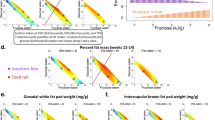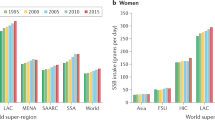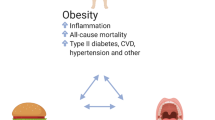Abstract
Obesity is a growing problem. In the broadest strokes, it is due to a small positive energy balance that persists over a sufficiently long time. Some forms of obesity develop independent of the type of diet that is eaten, whereas others are dependent on the diet. Among the former are individuals with leptin deficiency or genetic defects in the melanocortin 4 receptor. Most human obesity, however, occurs in the presence of highly palatable foods—fat and calorically sweetened beverages. The increase in obesity in the last 35 years has paralleled the increasing use of high-fructose corn syrup (HFCS), which first appeared just before 1970. Current soft drinks and many other foods are sweetened with this product because it is inexpensive and has useful manufacturing properties. The fructose in HFCS and sugar makes beverages very sweet, and this sweetness may underlie the relation of obesity to soft drink consumption. Fructose consumption has also been related to the metabolic syndrome and to abnormal lipid patterns. This evidence suggests that we should worry about our current level of fructose consumption, which has been increasing steadily for over 200 years and now represents over 10% of the energy intake of some people.
This is a preview of subscription content, access via your institution
Access options
Subscribe to this journal
Receive 12 print issues and online access
$259.00 per year
only $21.58 per issue
Buy this article
- Purchase on Springer Link
- Instant access to full article PDF
Prices may be subject to local taxes which are calculated during checkout


Similar content being viewed by others
References
Yudkin J . Pure, White and Deadly. Penguin Books: London, 1986.
Taubes G . Good Calories Bad Calories. Challenging the Conventional Wisdom on Diet, Weight Control and Disease. Alfred A Knopf: New York, 2007.
Cleave TL . Saccharine Disease. The Master Disease of Our Time. Keats Publishing, Inc: New Canaan, CT, 1974.
Bray GA . Metabolic Syndrome and Obesity. Humana Press: Totowa, NJ, 2007.
Drewnowski A, Darmon N . The economics of obesity: dietary energy density and energy cost. Am J Clin Nutr 2005; 82 (1 Suppl): 265S–273S.
Faith MS, Fontaine KR, Baskin ML, Allison DB . Toward the reduction of population obesity: macrolevel environmental approaches to the problems of food, eating, and obesity. Psychol Bull 2007; 133: 205–226.
Schlosser E . Fast Food Nation. Houghton Mifflin Co.: New York, 2001.
Nielsen SJ, Popkin BM . Patterns and trends in food portion sizes, 1977–1998. JAMA 2003; 289: 450–453.
Bray GA, Nielsen SJ, Popkin BM . Consumption of high-fructose corn syrup in beverages may play a role in the epidemic of obesity. Am J Clin Nutr 2004; 79: 537–543.
Havel P . Dietary fructose: implications for dysregulation of energy homeostasis and lipid/carbohydrate metabolism. Nutr Rev 2005; 63: 133–157.
Vartanian LR, Schwartz MB, Brownell KD . Effects of soft drink consumption on nutrition and health: a systematic review and meta-analysis. Am J Public Health 2007; 97: 667–675.
Paeratakul S, Ferdinand DP, Champagne CM, Ryan DH, Bray GA . Fast-food consumption among US adults and children: dietary and nutrient intake profile. J Am Diet Assoc 2003; 103: 1332–1338.
Dietz WH . Sugar-sweetened beverages, milk intake, and obesity in children and adolescents. J Pediatr 2006; 148: 152–154.
Ludwig DS, Peterson KE, Gortmaker SL . Relation between consumption of sugar-sweetened drinks and childhood obesity: a prospective, observational analysis. Lancet 2001; 357: 505–508.
Striegel-Moore RH, Thompson D, Affenito SG, Franko DL, Obarzanek E, Barton BA et al. Correlates of beverage intake in adolescent girls: The National Heart, Lung, and Blood Institute Growth and Health Study. J Pediatr 2006; 148: 183–187.
Berkey CS, Rockett HR, Field AE, Gillman MW, Colditz GA . Sugar-added beverages and adolescent weight change. Obes Res 2004; 12: 778–788.
Welsh JA, Cogswell ME, Rogers S, Rockett H, Mei Z, Grummer-Strawn LM . Overweight among low-income preschool children associated with the consumption of sweet drinks: Missouri, 1999–2002. Pediatrics 2005; 115: e223–e229.
Raben A, Vasilaras TH, Møller AC, Astrup AA . Sucrose compared with artificial sweeteners: different effects on ad libitum food intake and body weight after 10 wk of supplementation in overweight subjects. Am J Clin Nutr 2002; 76: 721–729.
Schulze MB, Manson JE, Ludwig DS, Colditz GA, Stampfer MJ, Willett WC et al. Sugar-sweetened beverages, weight gain, and incidence of type 2 diabetes in young and middle-aged women. JAMA 2004; 292: 927–934.
James J, Thomas P, Cavan D, Kerr D . Preventing childhood obesity by reducing consumption of carbonated drinks: cluster randomised controlled trial. BMJ 2004; 328: 1237.
Dubois L, Farmer A, Girard M, Peterson K . Regular sugar-sweetened beverage consumption between meals increases risk of overweight among preschool-aged children. J Am Diet Assoc 2007; 107: 924–934.
Aeberli I, Zimmermann MB, Molinari L, Lehmann R, l’Allemand D, Spinas GA et al. Fructose intake is a predictor of LDL particle size in overweight schoolchildren. Am J Clin Nutr 2007; 86: 1174–1178.
Nakagawa T, Hu H, Zharikov S, Tuttle KR, Short RA, Glushakova O et al. A causal role for uric acid in fructose-induced metabolic syndrome. Am J Physiol Renal Physiol 2006; 290: F625–F631.
Dhingra R, Sullivan L, Jacques RF, Wang TJ, Fox CS, Meigs JB et al. Soft drink consumption and risk of developing cardiometabolic risk factors and the metabolic syndrome in middle-aged adults in the community. Circulation 2007; 116: 480–488.
Phillips SM, Bandini LG, Naumova EN, Cyr H, Colclough S, Dietz WH et al. Energy-dense snack food intake in adolescence: longitudinal relationship to weight and fatness. Obes Res 2004; 12: 461–472.
Author information
Authors and Affiliations
Corresponding author
Additional information
Conflict of interest
George A Bray has received consulting fees from Orexigen, Amylin, Theracos and Herbalife as well as lecture fees from Vindico.
Rights and permissions
About this article
Cite this article
Bray, G. Fructose: should we worry?. Int J Obes 32 (Suppl 7), S127–S131 (2008). https://doi.org/10.1038/ijo.2008.248
Published:
Issue Date:
DOI: https://doi.org/10.1038/ijo.2008.248
Keywords
This article is cited by
-
Dietary fructose and its association with the metabolic syndrome in Lebanese healthy adults: a cross-sectional study
Diabetology & Metabolic Syndrome (2022)
-
Role of swimming on muscle PGC-1α, FNDC5 mRNA, and assessment of serum omentin, adropin, and irisin in high carbohydrate high fat (HCHF) diet induced obesity in rats
Egyptian Journal of Medical Human Genetics (2020)
-
Recent advances in the pathogenesis of hereditary fructose intolerance: implications for its treatment and the understanding of fructose-induced non-alcoholic fatty liver disease
Cellular and Molecular Life Sciences (2020)
-
The effects of four hypocaloric diets containing different levels of sucrose or high fructose corn syrup on weight loss and related parameters
Nutrition Journal (2012)
-
Dietary fructose and risk of metabolic syndrome in adults: Tehran Lipid and Glucose study
Nutrition & Metabolism (2011)



